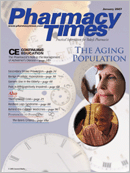Publication
Article
Pharmacy Times
Restless Legs Syndrome: Fighting the Urge to Move
Author(s):
When patients describe sensationsin their legs like burning,electricity, itching, thingscrawling under the skin, soda bubblingin the veins, or throbbing, restless legssyndrome (RLS) should come to mind.This sensorimotor disorder is characterizedprimarily by an urge to movelimbs (focal akathisia) because ofunpleasant sensations; only movementrelieves symptoms.1 Up to one third ofpatients with RLS experience pain.While legs are mostly affected, armsmay be involved; axial muscles arerarely affected. Symptoms are quiescegenic(occurring only during resting)and usually bilateral.2,3
RLS was first described in 1945, butpractitioners have only recognized it as aclinically significant and common disorderin the past 10 years. RLS is frequentlyassociated with sleep difficulties andnocturnal awakenings, leading to daytimefatigue and inability to concentrate.3Because sleep deprivation worsens RLSsymptoms, a vicious cycle ensues.4Depression and anxiety are common andappear to be consequences of the disorder.One study, for example, identifieddepression or other affective diagnosesin 43.7% of RLS males and 46.1% of RLSfemales.5 Increased prevalence of hypertensionand heart disease accompaniesRLS, and RLS patients tend to have pooreroverall health.3 Among children, RLS isassociated with attention-deficit/hyperactivitydisorders.6
Adult RLS prevalence is estimated at7% to 10%, with increased frequency infemales. Onset usually occurs betweenages 35 and 70, with symptoms worseningwith age. Peripheral neuropathy andradiculopathy accompany late onset.7Between 50% and 70% of victims have afirst-degree relative with RLS.2,3 Environmentalcontributors include smoking,caffeine, and lack of exercise. Some,but not all studies, report an associationwith alcohol intake and body massindex.2,3
Etiology
RLS etiology is either primary or secondary.Primary RLS, which is generallyidiopathic, involves the central nervoussystem. The dopaminergic pathways' roleis well documented, demonstrated byRLS symptom resolution with dopaminergicagonists and symptom exacerbationwith dopamine antagonists.2
Iron deficiency is common, and aninverse relationship exists between ironstores and RLS symptom severity.1 Bothdopamine and iron vary with the circadiancycle, both reaching nadirs when maximumRLS symptoms occur. Becausedopamine synthesis requires iron, serumferritin levels and iron percent saturationassessment should be routine in RLS.7
RLS may be secondary to other causes,and clinicians should approach RLS as apotential marker for underlying comorbidities.Secondary causes include irondeficiency (with or without anemia), renalfailure, diabetes, rheumatoid arthritis,fibromyalgia, vitamin deficiency (folate,B12), hypothyroidism, and pregnancy.3 Upto 23% of pregnant women, for example,report RLS.2 Often, treatment of theunderlying condition resolves RLS.
Diagnostic Criteria
Four essential criteria are required fordiagnosis. In their absence, a probableRLS diagnosis is made based on supportingclinical features (Table 1). In the cognitivelyimpaired elderly, behavioral manifestationsguide diagnosis (Table 2).
RLS assessment should rule out secondarycauses and mimicking conditions,especially nighttime cramps and periodiclimb movement (PLM) disorders. The latteris especially important. While PLM iscommon in RLS patients, an importantdistinction exists: PLM is involuntary,whereas RLS patients move limbs voluntarilyto relieve sensations. Other conditionswith leg discomfort include arterialand venous insufficiencies, myopathies,small fiber neuropathies, arthritis, neuroleptic-induced akathisia, and positionaldiscomfort or ischemia.3 Table 3 highlightsRLS's differentiating characteristics.
Treatment
Symptom frequency (intermittent RLSwith occurrence 2-3 times weekly vs dailyRLS) and severity (mild, moderate, refractory)dictate treatment. While treatmentfor secondary RLS focuses on underlyingetiology, treatment for RLS relief is thesame for all patients. Nonpharmacologicinterventions include:
- Eliminating or reducing agentsknown to precipitate RLS (dopamine-blockingagents, antidepressants,antihistamines, caffeine, alcohol, andnicotine)
- Improving sleep hygiene (eg, regularsleep and wake times, warm bathsbefore bedtime)3
Levodopa is effective in the short term,but its therapeutic effects are confinedto the first 4 to 6 hours in bed.1 Studiesreveal that up to 82% of patients experiencesymptomaugmentation withdaily levodopa useand/or doses greaterthan 200 mg daily.8Augmentation is aniatrogenic worseningof RLS with decreasedresponsivenessto the medication,accompaniedby earlier daily symptomonset and symptom progressionto previously uninvolved areas.Augmentation resolves with medicationcessation.8
Because of augmentation, dopamineagonists are preferred as first-lineagents, but augmentation still occurs in10% to 35% of treated patients.3Dopaminergic agents include ergot derivatives(pergolide) and non-ergot dopamineagonists (pramipexole, ropinirole).1Ropinirole is the only FDA-approvedagent for RLS. Because ergot-relateddopamine agonists have been linked tofibrotic and cardiac valvular problems,nonergoline agonists are preferred.9,10Dopamine agonists should be titratedfrom minimal dose until symptom reliefis achieved. Severe daytime sleepinesshas been reported in Parkinson's diseasepatients on dopamine agonists.1
Second-line agents include the use ofopioids (oxycodone, propoxyphene,codeine) for relief when first-line agentsare ineffective. Benzodiazepines may beused for their sedative effects for sleepdeprivation. Oral iron is recommendedfor patients with serum ferritin levels <45to 50 μg/L.2
Consensus is lacking for refractoryRLS treatment, but consideration maybe given to changing dopamine agonists,switching to an opioid or anticonvulsant,and adding a second medication,possibly with a reduced agonistdose (Table 4).1,3
Dr. Zanni is a psychologist and health-systemsconsultant based inAlexandria,Va.
References
1. Hening WA, Allen RP, Earley CJ, Picchietti DL, Silber MH. Restless LegsSyndrome Task Force of the Standards of Practice Committee of the AmericanAcademy of Sleep Medicine. An update on the dopaminergic treatment of restless legs syndromeand periodic limb movement disorder. Sleep. 2004;27:560-583.
2. Chahine LM, Chemali ZN. Restless legs syndrome: a review. CNS Spectr. 2006;11(7):511-520.
3. Hening WA. The diagnosis and management of restless legs syndrome. Available at:www.medscape.com/viewprogram/5101. Accessed October 24, 2006.
4. Zarcone VP Jr. Sleep hygiene. In: Kryger MH, Roth T, Dement WC, eds. Principles andPractice of Sleep Medicine. 3rd ed. Philadelphia, Pa: WB Saunders; 2000: 657-661.
5. Banno K, Delaive K, Walld R, Kryger MH. Restless legs syndrome in 218 patients: associateddisorders. Sleep Med. 2000;1:221-229.
6. Picchietti DL, England SJ, Walters AS, Willis K, Verrico T. Periodic limb movement disorderand restless legs syndrome in children with attention-deficit hyperactivity disorder. J ChildNeurol. 1998;13:588-594.
7. Allen RP, Picchietti D, Hening WA, et al. Restless legs syndrome: diagnostic criteria, specialconsiderations, and epidemiology: a report from the restless legs syndrome diagnosis andepidemiology workshop at the National Institutes of Health. Sleep Med. 2003;4:101-119.
8. Allen RP, Earley CJ. Augmentation of the restless legs syndrome with carbidopa/levodopa.Sleep. 1996;19:205-213.
9. Shaunak S, Wilkins A, Pilling JB, Dick DJ. Pericardial, retroperitoneal, and pleural fibrosisinduced by pergolide. J Neurol Neurosurg Psychiatry. 1999;66:79-81.
10. Horvath J, Fross RD, Kleiner-Fisman G, et al. Severe multivalvular heart disease: a newcomplication of the ergot derivative dopamine agonists. Mov Disord. 2004;19:656-662.







